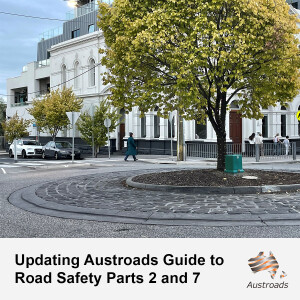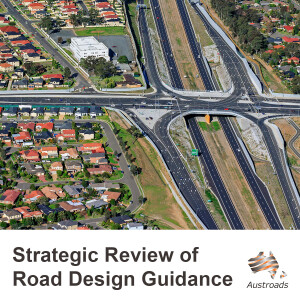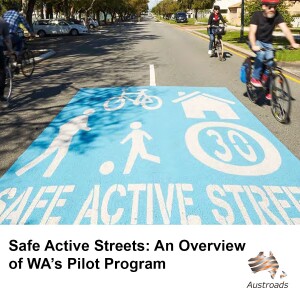Episodes

Wednesday Jul 24, 2024
Policy and Other Non-Infrastructure Measures to Increase Active Transport Mode Share
Wednesday Jul 24, 2024
Wednesday Jul 24, 2024
This is the final webinar in the three-part webinar series to present the outcomes of the Austroads project “Prioritising Active Transport”.
Presenters Dr Elliot Fishman and Andrew Somers focus on various policies and other non-infrastructure interventions that can be used to increase levels of active travel. These interventions include measures such as speed reduction, policies to integrate public transport with walking and cycling, pricing measures for motor vehicle use and parking and shared micromobility programs.
The session also covers how policy and other non-infrastructure interventions perform in terms of their impact on growing active transport mode share, in comparison to the cost and complexity of implementing these initiatives.

Tuesday Jul 23, 2024
Tuesday Jul 23, 2024
This is the second session in a three-part webinar series to present the outcomes of the Austroads project “Prioritising Active Transport”. This webinar builds on the first webinar by focusing on the types of infrastructure interventions that can be used to increase active transport mode share.
Participants will gain an understanding of the effectiveness of these interventions and their suitability, depending on the geographical context (e.g. inner city, suburban, regional).
The webinar is presented by Dr Elliot Fishman and moderated by Andrew Somers.

Tuesday Jul 23, 2024
Increasing Active Transport Mode Share
Tuesday Jul 23, 2024
Tuesday Jul 23, 2024
This webinar was part one of a three-part webinar series to present the outcomes of the Austroads project 'Prioritising Active Transport'.
A wide range of Australian government agencies have a goal to increase the mode share for walking and cycling. Yet much of the data shows that active transport levels have stagnated over the last 15 years. This webinar presented data on Australian and overseas best-practice measures that can be implemented to grow the contribution of walking and cycling to transport systems across Australasia.
Participants learnt about the different categories of interventions that can be used to increase active transport mode share. They also learnt how a prioritisation framework can be used to select interventions that are the most impactful in boosting walking and cycling mode share, while also considering the cost and complexity of different interventions.
The webinar was presented by Dr Elliot Fishman and moderated by Andrew Somers.

Thursday Jul 11, 2024
Gender Sensitive Urban Design Guidelines
Thursday Jul 11, 2024
Thursday Jul 11, 2024
Cities throughout the world are recognising many public spaces are not welcoming or inclusive, particularly for women, girls, gender diverse groups and vulnerable people.
This webinar, presented by Anna Chauvel and Richmond Henty, focuses on Canberra's first Gender Sensitive Urban Design Guidelines. The guidelines will help planners, engineers, architects, landscape designers and developers create urban spaces that reflect the needs, interests, and routines of the city’s diverse community, enriching people’s daily lives.
Developed following over two years of community and stakeholder engagement, the guidelines will aid with the design and delivery of public urban spaces as well as transport and infrastructure projects, including wayfinding. The guidelines are one of the actions to come out of the Second Action Plan 2020-22 of the ACT Women’s Plan.
The guidelines will deliver practical outcomes to the daily lives of women, girls, gender diverse and vulnerable people in Canberra improving their safety, access, mobility, health, and enjoyment in public spaces.

Tuesday Jul 09, 2024
How to Design Better Cities for Women and Girls
Tuesday Jul 09, 2024
Tuesday Jul 09, 2024
Safety is often the first thing that comes to mind when thinking about transport and city planning from a gender perspective, but feeling safe should be the baseline, not the benchmark when it comes to inclusive cities.
From Barcelona’s Superblocks to women’s cycling rates in Copenhagen, through to building women’s autonomy into the business case, this webinar’s presenter Estelle Grech shares key insights from her Churchill Fellowship where she travelled to 14 cities around the globe to research how to design cities for women in girls.

Wednesday Jul 03, 2024
Updating Austroads Guide to Road Safety Parts 2 and 7
Wednesday Jul 03, 2024
Wednesday Jul 03, 2024
The Austroads Guide to Road Safety Part 2: Safe Roads (AGRS Part 2) and Guide to Road Safety Part 7: Road Safety Strategy and Management (AGRS Part 7) have recently been updated.
AGRS Part 2 is designed to provide all levels of government across Australia and New Zealand with information on the role infrastructure plays in the Safe System. AGRS Part 2 presents guidance on the selection and implementation of infrastructure treatments to reduce road trauma and deliver a zero-harm future. These guidelines cover network risk assessment techniques and present a suite of infrastructure interventions (proven and emerging) that can be implemented to address the key road safety issues on our road networks: high-speed lane departures, intersections, and vulnerable road users. Interventions are categorised using a treatment hierarchy approach aligned with Safe System principles. The Guide contains practical, hands-on advice to help practitioners identify, prioritise, and deliver infrastructure interventions that are aligned with Safe System principles and the contemporary Zero Planning approach to road safety.
The AGRS Part 7 was expanded to include other network-wide concepts and processes, such as Network Safety Planning, Future State Modelling (backcasting) and Movement and Place Frameworks. It also identifies how the different parts/pillars of the Austroads Guide to Road Safety can be used to develop solutions that work towards network aspirations and significantly reduce serious road trauma.
This webinar, presented by Hafez Alavi and Paul Durdin, outlines the key changes to AGRS Part 2 and AGRS Part 7. The content includes examples from both guides that demonstrate how the updated guidance would be practically interpreted by practitioners to deliver treatment outcomes that are more aligned with the Safe System approach.

Tuesday Jun 25, 2024
Austroads Coober Pedy Sprayed Seal Trial – 11-Year Inspection Findings
Tuesday Jun 25, 2024
Tuesday Jun 25, 2024
A large proportion of the road networks in Australia and New Zealand consist of flexible granular pavements protected by sprayed sealing surfacings. An Austroads sprayed seal trial site was established in Coober Pedy in South Australia during 2011 to evaluate the relative performance of seals constructed with different grades of binders from their placement through to long‑term service. The site was constructed to predominantly compare the performance of different Austroads Technical Specification ATS 3110 polymer modified binder (PMB) grades when they were used in strain alleviating membrane (SAM) applications.
This webinar, presented by Steve Patrick and Dr Robert Urquhart, describes the findings obtained from an inspection of the trial site conducted 11 years after construction. The inspection included detailed visual assessments of the condition of each trial section by an expert team. Seal samples were also obtained from the trial sections so that binders could be extracted for rheological and chemical analysis tests. The test results obtained for the extracted binder samples have been used to gain insights into how the properties of the trial binders have changed over time.
The results of the visual assessment work indicated that all sections of the trial site were generally performing well after 11 years of service. Extracted binder sample tests indicated that all binders have become progressively harder over time. The control C170 bitumen section of the trial site has hardened more over time than the sections containing PMBs.

Monday Jun 24, 2024
Local Government Readiness for Connected and Automated Vehicles
Monday Jun 24, 2024
Monday Jun 24, 2024
This webinar is aimed at helping local governments (LGs) across Australia and New Zealand navigate the evolving landscape of connected and automated vehicles (CAVs). As managers of a large portion of the road network, LGs play a pivotal role in shaping the future of transport.
This webinar provides an overview of an Austroads project that developed guidance to enhance LGs’ preparedness for CAV integration. The webinar explores ten critical areas essential for LGs seeking to prepare effectively, spanning legal considerations and infrastructure readiness as well as financial impacts and stakeholder engagement. The session will also outline the proposed actions to support current and near-term vehicles with human operators and longer-term, fully automated vehicles.
The webinar also covers a proposed LG CAV Preparedness Framework and an Inflection Point Monitoring tool developed to assist LGs with decision making amidst the evolving landscape of CAV adoption.
The webinar starts by presenting the results of the initial consultation exercise, giving context to the understanding of what LGs considered to be most useful and relevant for their needs. It will then run through an overview of the developed tools and resources.
The webinar is presented by David Yee and Andrew Somers.

Tuesday Apr 23, 2024
Strategic Review of Road Design Guidance
Tuesday Apr 23, 2024
Tuesday Apr 23, 2024
For decades, Austroads Guide to Road Design (AGRD) has served as a critical resource for practitioners involved in road planning, design and engineering. Austroads recently completed a strategic review of road design guidance, identifying strategies to sustainably maintain the AGRD as the pre-eminent road design guide in Australia and New Zealand.
Through an online survey and face-to-face interviews, the project team identified opinions and possible strategic actions from users of the AGRD, stakeholders in road design practice and international experts. This webinar describes what the review learned, and the nature of actions proposed to realise identified opportunities.
Webinar presenters, Andrew Somers and Dr Rod Troutbeck, report on the findings of the engagement with the AGRD’s users and non-users. Provided feedback identified that road design must be context-sensitive and Austroads’ road design guidance needs to cover the range of contexts and the application of judgement is a critical part of context-sensitive designs and solutions.
The presenters also explore how changes to structure and content might allow the AGRD to:
- better cover urban environments
- integrate guidance for planning and design
- more effectively promote context-sensitive design practices
- establish clearer links to supporting evidence.

Tuesday Apr 09, 2024
Safe Active Streets – An Overview of WA's Pilot Program
Tuesday Apr 09, 2024
Tuesday Apr 09, 2024
The Department of Transport Western Australia has been working with Western Australian local governments to develop, trial and evaluate ‘safe active streets’ to encourage more people to walk, wheel and ride in their communities.
The pilot program trialled and adapted common local area traffic management treatments to create 30 km/h environments with unique designs created that reflect local community needs and context.
This webinar explores the origins of the program, how and why it started, it will share high-level insights from the evaluation, including what worked, what didn’t and what was learnt along the way. It also shares ‘where to next’ for the program and how this work will be used to inform guidelines to support the delivery of safe active street infrastructure by local government into the future.
The webinar is presented by Caroline Elliott and Helen Ginbey, moderated by Sam Bolton.
This webinar is part of the Cycling and Walking Australia and New Zealand (CWANZ) webinar series. CWANZ is the Australasian lead reference group for walking and bike riding on transport and recreation networks. For further information please visit www.cwanz.com.au

